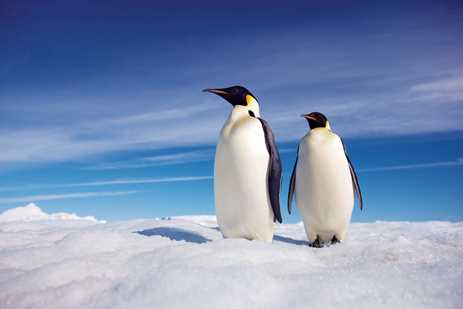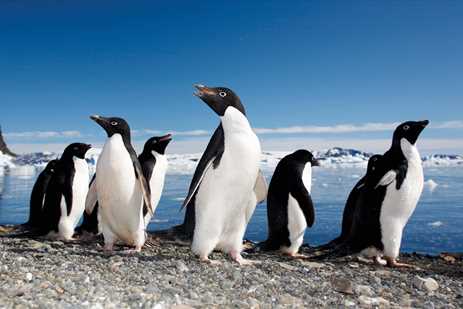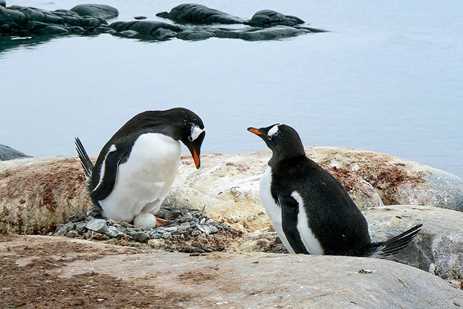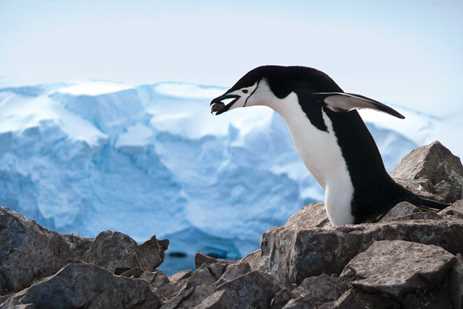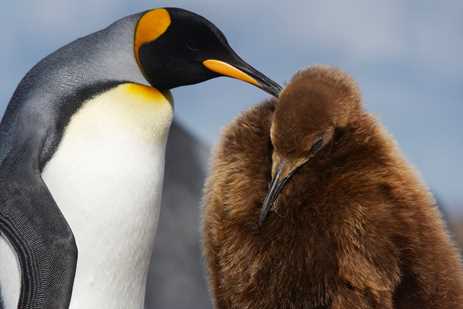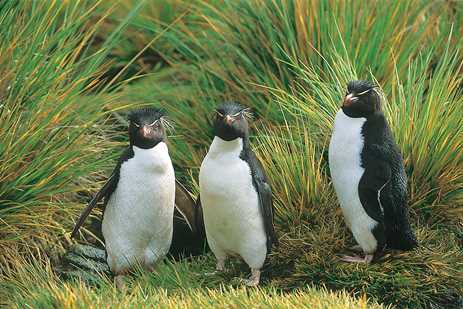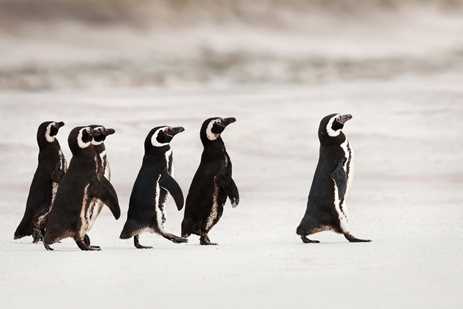Nov 2020
5 Min Read

Eight of the world’s 18 penguin species live in Antarctica and the subantarctic islands of the Falklands and South Georgia. When you travel with National Geographic-Lindblad Expeditions you'll have the thrilling opportunity to witness these incredible birds in their fragile habitats—many of which are protected through critical conservation efforts supported by the Lindblad Expeditions-National Geographic Fund. Before you head into the Southern Ocean, learn how to tell a gentoo from a chinstrap and an emperor from a king with this penguin primer.
Where to spot them: Ross Sea and Weddell Sea region, especially Snow Hill Island
Anyone who has seen March of the Penguins knows these emblematic penguins endure unimaginable obstacles to keep the species going. Unlike all other penguins, which nest on land, emperors make their colonies on the sea ice, likely never once stepping foot on land. Males lose almost half their body weight while incubating the egg in a special brood pouch, so as soon as mom returns with food for the newly hatched baby, dad heads to the ocean to take his turn. These incredible swimmers dive deeper and longer than any other bird, up to 700 feet, and can stay underwater for 18 minutes as they hunt crustaceans, squid and fish.
Sighting an emperor penguin on an Antarctica expedition is one of the most thrilling events. Standing at nearly four feet tall and weighing up to 99 pounds, the largest of all penguin species is usually encountered alone or in very small groups on sea ice. While emperor penguins are closely related to king penguins and have a somewhat similar appearance, it’s much more massive for its size than the king. Look for that iconic penguin tuxedo and broad yellow patches on each side of the head.
Where to spot: Near the tip of the Antarctic Peninsula to the islands and mainland in the Ross Sea
This is the species most people think of when they envision a typical penguin—the classic little man in a tuxedo. Adélies are entirely black and white with a distinct white ring around the eye and no bright colorful markings. They are one of three species of brush-tailed (or pygoscelis) penguins along with the gentoo and the chinstrap, and as the name implies their tails have very stiff feathers which stick out like a brush. Adélies in particular have a relatively long tail compared to most other species.
During breeding season, huge colonies commonly form with hundreds of thousands of individuals. Both courting and breeding are brief—it’s one of the shortest of all other penguins—with a lot of flipper-waving and calls. Males also present females with pebbles as a token of affection. Their molting period, which occurs at the end of the breeding season, is as swift as the mating period. Colonies can evacuate and disappear seemingly overnight.
Where to spot: Northern Antarctic Peninsula and several subantarctic islands including South Georgia, the Falklands, the South Shetlands, and Macquarie Island
Although gentoos are the least common species on the Peninsula, their colonies are usually established in places that are easily accessible for Antarctic visitors. They are also just as easy to identify, even from a good distance, thanks to the white triangular patch above each eye and brilliant orange-red “lipstick” markings on their beak. Plus, there’s their 6-inch long prominent brush-tail.
Gentoos are also found on many subantarctic islands where they seem equally happy nesting on a pebbly beach or grass tussocks as they are on rocky outcrops in the snow. Since these birds build their nests with stones, the males often woo females with carefully chosen pebbles offered up as gifts—a fun and endearing behavior to witness in person. All that romance must do the trick because gentoo parents often form long-lasting bonds and are very nurturing caretakers. Watching gentoo antics on land is exciting but try to spot them in the water where they truly shine. These birds can swim up to 22 miles per hour—faster than any other diving bird—and dive to depths of 655 feet.
Where to spot: This abundant species is found all over Antarctica and the subantarctic islands
The third member of the brush-tails, chinstraps look similar to the Adélies in both markings and size except for a narrow black band (or strap) under the head which makes it look like it’s wearing a small helmet. With roughly 7 million pairs in the world, this is one of the most abundant species so chances are you’ll see plenty of them when you make landfall. Also like Adélies, the chinstraps tend to form huge colonies numbering in the hundreds of thousands or more. Mates give an incredible performance, aptly named the ecstatic display, when they are courting or exchanging places at their nests. They’re very social birds in general and have multiple forms of communication from bowing and preening to flipper and head waving. But they’re also one of the most aggressive species of penguins which can lead to some very heated showdowns over nesting space.
Where to spot: Only on subantarctic islands. St. Andrews Bay on South Georgia has a significant rookery
Nothing can quite prepare you for the soul-stirring experience of coming ashore on South Georgia and seeing tens of thousands of stately king penguins all on a single beach. The most striking and brightly colored of the Southern Ocean penguins, kings are second in size to the emperor and sport a beautiful yellow-orange throat patch, an orange, inverted teardrop-shaped marking on either side of their black heads, and long, curved elegant beaks. Since they form breeding colonies on subantarctic islands and not sea ice, king penguins can spread their breeding season over a much longer time, between 14 and 16 months. They also spend a much longer time raising and caring for their chicks.
Like emperors, kings do not build nests but incubate their egg on their feet, keeping it warm under a feathery fold of skin. Both parents take turns incubating for periods of 1 to 2 ½ weeks while the other goes off to hunt. Chicks have fluffy brown plumage until about a year old when they acquire their adult feathers and coloring. They look so different from their parents that juveniles were once thought to be a different species. Sailors christened them ‘oakum boys' as the brown plumage reminded them of the color of oakum used to caulk timbers on sailing ships.
Where to spot: Subantarctic islands often on steep cliffs
Rockhoppers are one of the most fun penguins to watch as they hop among rocks and boulders, sometimes stumbling or even tumbling down. Standing less than 24 inches, rockhoppers are the smallest of the Southern Ocean penguins which adds to their charming allure. The distinct yellow plumes above their red eyes are also endearing. These penguins are part of the crested group along with macaroni penguins (and several other species located in other regions) and they’re the most elaborately adorned of all penguins.
The rockhopper penguin typically nests on steep, rocky shorelines with direct access to the sea, although these preferred sites often involve a lengthy, difficult climb to reach. But this tenancious species patiently hops back and forth. You’ll often find their colonies nearby or mixed in with nesting albatrosses, another fascinating bird to observe.
Where to spot: Close to the Antarctic Convergence Zone and subantarctic islands including Falklands, South Georgia and South Sandwich
Another crested penguin, the macaroni is so named because it brought to mind the English dandies of the 17th century who sported gaudily plumed hats and outrageous costumes. This scrappy little penguin closely resembles a rockhopper but its crest is gold in color and considerably thicker. Not only are macaronis the most common penguin in Antarctica, they are the most numerous species of all penguins with an estimated nine million pairs. However, since it typically nests along steep, rocky shorelines on isolated, storm-tossed islands it does make encounters with them much harder. Good news is individual pairs have an unusual habit of nesting within the colonies of other species, so it is possibly a few will be sighted.
Where to spot: Falkland Islands and Tierra del Fuego
Ferdinand Magellan, the famed Portuguese explorer, lends his name to these skittish penguins which his crew came across on their attempt to circumnavigate the world in 1520. Another more classic-looking penguin they are all black and white, except for a small but noticeable region of pink flesh on the face that flushes red as they get excited or try to cool off on land. They also shed beak feathers, pant and stretch their flippers to catch a breeze and release excess heat. Additional distinguishing traits include two black bands that run across the top part of their white bellies and a stretch of white feathers swooping down from each eye and around the neck.
Unlike any of the other species listed here Magellanics nest underground in burrows. They typically mate for life and return year after year to the same nesting site from which they hatched. Once chicks reach a suitable size they vacate their subterranean homes and (like most other juvenile penguins) form dense creches for protection near the closest beach.
